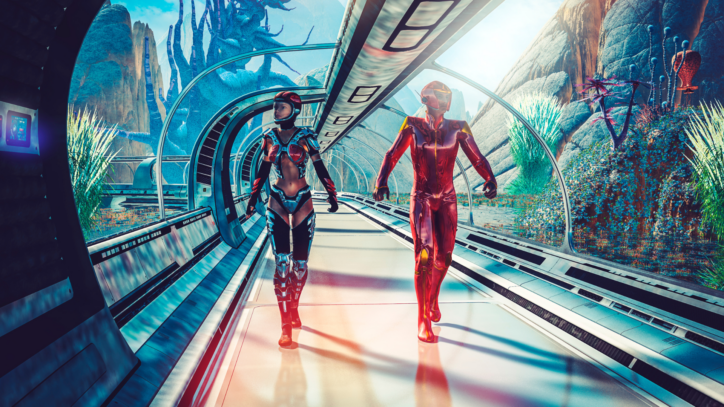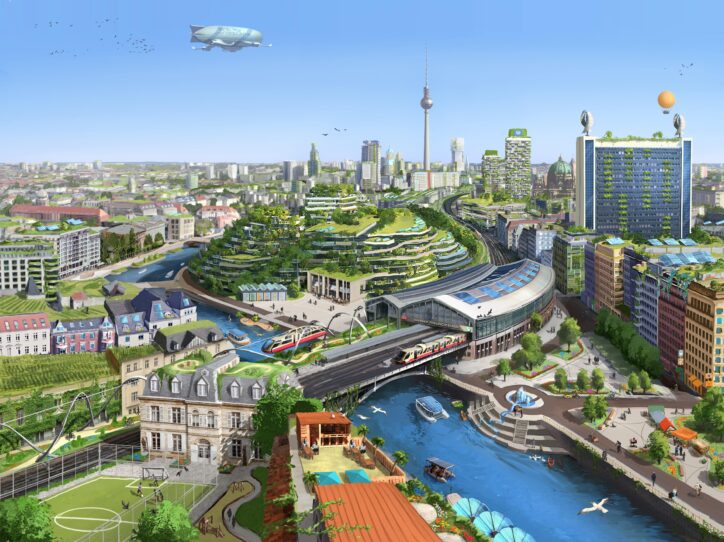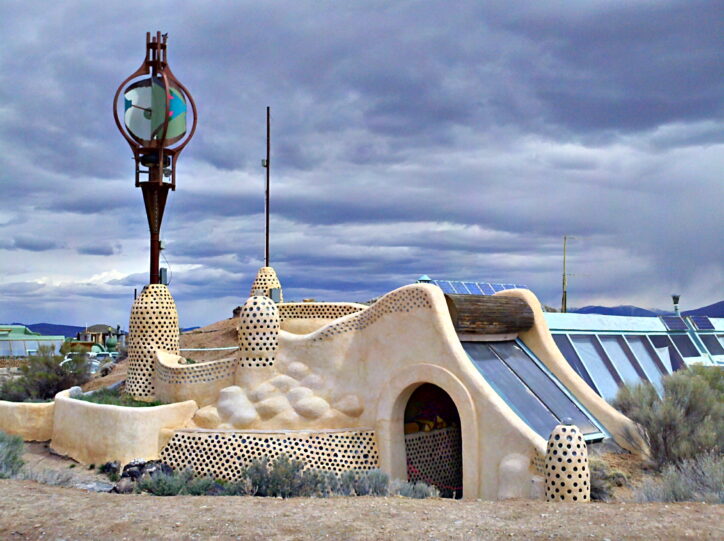Solarpunk: The radically optimistic vision of the future we need right now?

As climate anxiety reaches a fever pitch and warnings of environmental catastrophe dominate headlines, envisioning a livable future can seem impossible. Yet giving in to doom and gloom risks creating a self-fulfilling prophecy. That’s why the Solarpunk movement offers such a breath of fresh air.
Solarpunk is an artistic and literary genre that depicts an attainable, sustainable future, one where climate disaster is averted through environmental regeneration and the thoughtful application of technology.
By using renewable energy as its basis rather than fossil fuels, embracing nature instead of artificiality, and envisioning worlds where effective climate action succeeds, Solarpunk provides a sorely needed antidote to eco-pessimism. It sparks optimism and expands what we believe is possible, fueling the drive for real change. Unlike dystopias saturated with corporate greed like Cyberpunk, Solarpunk systems are decentralized, egalitarian, and community-oriented. The Solarpunk ethos refuses to accept that environmental and social ruin are inevitable outcomes of progress.
Through its visual language of living architecture, renewable technologies seamlessly embedded in society, and the tangible fruits of environmental recovery, Solarpunk kindles radical hope. It portrays a future not only worth fighting for but one well within our capability to create. The passion and creativity of this movement demonstrate that, despite all indications to the contrary, there are still alternatives. Better worlds await if we dare to imagine them into being.
To discover more about the potential, limitations, and optimistic vision of Solarpunk, continue reading below.

What is Solarpunk?
Solarpunk is a literary and artistic movement emerging as a response to the pessimism and eco-anxiety prevalent today. First coined in the late 2000s and popularized on Tumblr in 2014, solarpunk envisions stories and images of a future where climate disaster is avoided through environmental regeneration and ingenuity.
Unlike prevalent apocalyptic narratives, Solarpunk aims to kindle optimism about the future. It shows green, sustainable worlds that could plausibly exist if humanity succeeds in addressing climate change with care and conscience. Solarpunk worlds are decentralized and egalitarian, using appropriate technologies powered by renewable energy to enable communities to thrive within ecological limits.
The “solar” in Solarpunk refers to renewable energy replacing fossil fuels. Solar panels, wind turbines, and other clean technologies are seamlessly integrated to enable a post-scarcity, circular economy. The “punk” denotes the movement’s enthusiasm for radical social change and rebellion against current destructive paradigms. Solarpunk uses aesthetics and narratives to help people imagine – and thus work towards creating – a brighter future.
Four key themes exemplify Solarpunk’s unique perspective:
- Refusing pessimism. Rather than dystopias, Solarpunk shows optimistic outcomes from tackling problems like pollution and inequality. It keeps hope alive.
- Sustainable technology. Clean energy innovations enable sustainable societies, improving lives without sacrificing nature. This contrasts with much sci-fi where tech worsens problems.
- Do-it-yourself (DIY) ethics. Solarpunk embraces solutions like local community gardens and repair cafes – small-scale, bottom-up systems that increase resilience.
- Convivial conservation. Cooperation, not conflict, underpins Solarpunk visions between humans and nature. We transition from exploitation to symbiosis.
By portraying worlds where green technologies, grassroots innovation, and environmental recovery flourish, Solarpunk is planting seeds for the sustainable paradigms it dreams of. It depicts not perfect utopias but preferable futures where technology serves ecology to foster human and planetary wellbeing. These stories spark inspiration to guide our choices today.

The Optimism of Solarpunk
In contrast to the nihilism of cyberpunk and the pervasiveness of “cli-fi” (climate fiction) dystopias, Solarpunk unapologetically embraces optimism about the future. Rather than perceive environmental breakdown as inevitable, Solarpunk chooses to envision worlds where humanity succeeds in addressing problems like climate change and inequality.
Solarpunk worlds are not naive utopias; struggle still exists. Yet, the genre pointedly avoids resigning itself to failure. This optimism is radical in that it provokes us to reject fatalism and believe transformative change can happen.
These alternative futures subsequently become inspiring visions for climate activists fighting despondency about progress. Research shows that climate messaging focused solely on doom and gloom risks disempowering people, feeding eco-anxiety and eco-grief. Yet solarpunk creates space for outrage at injustice as well as care for the planet. It recognizes our emotional bandwidth is limited; we must hold hope alongside grief to avoid burnout.
In Solarpunk art and stories, constructive responses to disasters do not gloss over suffering but memorialize it, refusing to forget yet choosing to keep faith in rehabilitation. The Solarpunk ethos believes that even if positive change seems improbable, that is no reason to dismiss advocating and working toward it. Resultingly, its imaginings of societies healing both social rifts and environmental degradation spark motivation. They demonstrate that despite indications to the contrary, alternatives and second chances still await.
Solarpunk uses aesthetics, narratives, and ideas to kindle radical hope – the belief that transformation can emerge from devastation through collective effort. Its visual language helps expand mindsets trapped by capitalist realism.
After all, if Solarpunk inspires even one more tree planted, panel installed, or call to a representative, it proves that optimism itself can facilitate action.

Is Solarpunk What We Need Right Now?
At a time of climate crisis, political polarization, and prevailing dystopian mindsets, Solarpunk’s optimism and visions of preferable futures could not be more relevant. Its narratives spark motivation to create the world we wish to see instead of resigning ourselves to disaster. The Solarpunk ethos believes imagination itself facilitates change; we cannot build what we cannot first envision.
Solarpunk also promotes crucial values for the world today like environmentalism, social justice, and community-oriented systems. Its art and stories envision decentralized societies that prioritize equality, ethical innovation, and living joyfully within ecological limits. Solarpunk uses aesthetics and narratives to render concepts like degrowth and appropriate technology irresistibly compelling rather than boring or frightening. It makes space for spiritual perspectives alongside science, refusing to silo wisdom into boxes.
At its best, Solarpunk recognizes no single solution but an ecosystem of complementary approaches, from policy and individual choices to grassroots organizing and technology. It sees beauty in both cutting-edge clean energy infrastructure and longstanding tactics like composting. Likewise, Solarpunk leverages imagination as a strategy itself while also sparking real-world models to learn from.
For example, Singapore’s Supertrees, vertical farming, and solar cooperatives all exemplify Solarpunk principles scaled up.
We cannot wait for flawless roadmaps, Solarpunk tells us; we must build the future we wish for with the tools and knowledge available now, accepting imperfection while aiming for net positive impact and staying fixated on the horizon goal.
Our current track promises only hardship; we desperately need more compass points guiding us toward habitats where all life can flourish. By boldly exercising creativity and conscience, Solarpunk illuminates potential even amid uncertainty.

Critiques, Limitations, and Inspiration
Of course, Solarpunk is not without its limitations. As an emerging movement intersecting environmentalism, social justice, and speculative fiction, it risks being seen as unrealistic or co-opted. Some critique Solarpunk’s visions as greenwashed techno-optimism, disregarding the roots of our problems.
Others argue its goals are implausible given real-world political and infrastructural obstacles. Solarpunk worlds rely on decentralization, open-sourced systems, and circular economies scaling up. Achieving that level of transition requires immense change. Critics question whether Solarpunk adequately engages with the feasibility challenges of its propositions.
There are also debates around Solarpunk’s accessibility. Its artistic aesthetics incorporate what some describe as elite tastes like art nouveau along with expensive green technologies. This raises issues about Solarpunk privileging certain cultural perspectives over others in defining sustainability.
Regardless of limitations, Solarpunk’s value lies in expanding imaginations trapped by cynicism. It creates visions of what is possible, opening doors to alternatives beyond capitalism’s strictures and nurturing radical hope – the bedrock belief that change can emerge through collective care.
By boldly exercising creativity, Solarpunk reveals potential for symbiosis with nature in contrast with common assumptions that suffering is unavoidable, and that existence must be a struggle between binaries.
Aligning beautifully with youth climate strikes and environmental justice movements, Solarpunk’s urgency and magic are precisely what we need during pessimistic times. Its visions prove that despite indications to the contrary, there are still spaces left unexplored where all life can flourish. We need only dare expand our sight to see them.
